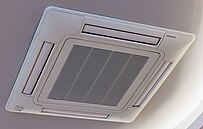
Back Lugversorging AF تكييف الهواء Arabic Aire acondicionao AST Климатизация Bulgarian শীতাতপ নিয়ন্ত্রণ ব্যবস্থা Bengali/Bangla རླུང་དྲོད་སྙོམ་ཆས། BO Aire condicionat Catalan Kŭng-dièu CDO Tootómôhéó'o CHY فێنککەرەوە CKB
Air conditioning, often abbreviated as A/C (US) or air con (UK),[1] is the process of removing heat from an enclosed space to achieve a more comfortable interior temperature (sometimes referred to as 'comfort cooling') and in some cases also strictly controlling the humidity of internal air. Air conditioning can be achieved using a mechanical 'air conditioner' or by other methods, including passive cooling and ventilative cooling.[2][3] Air conditioning is a member of a family of systems and techniques that provide heating, ventilation, and air conditioning (HVAC).[4] Heat pumps are similar in many ways to air conditioners, but use a reversing valve to allow them both to heat and to cool an enclosed space.[5]
Air conditioners, which typically use vapor-compression refrigeration, range in size from small units used in vehicles or single rooms to massive units that can cool large buildings.[6] Air source heat pumps, which can be used for heating as well as cooling, are becoming increasingly common in cooler climates.
Air conditioners can reduce mortality rates due to higher temperature.[7] According to the International Energy Agency (IEA) 1.6 billion air conditioning units were used globally in 2016.[8] The United Nations called for the technology to be made more sustainable to mitigate climate change and for the use of alternatives, like passive cooling, evaporative cooling, selective shading, windcatchers, and better thermal insulation.
- ^ "Air Con". Cambridge Dictionary. Archived from the original on May 3, 2022. Retrieved January 6, 2023.
- ^ Dissertation Abstracts International: The humanities and social sciences. A. University Microfilms. 2005. p. 3600.
- ^ 1993 ASHRAE Handbook: Fundamentals. ASHRAE. 1993. ISBN 978-0-910110-97-6.
- ^ Enteria, Napoleon; Sawachi, Takao; Saito, Kiyoshi (January 31, 2023). Variable Refrigerant Flow Systems: Advances and Applications of VRF. Springer Nature. p. 46. ISBN 978-981-19-6833-4.
- ^ Agencies, United States Congress House Committee on Appropriations Subcommittee on Dept of the Interior and Related (1988). Department of the Interior and Related Agencies Appropriations for 1989: Testimony of public witnesses, energy programs, Institute of Museum Services, National Endowment for the Arts, National Endowment for the Humanities. U.S. Government Printing Office. p. 629.
- ^ "Earth Tubes: Providing the freshest possible air to your building". Earth Rangers Centre for Sustainable Technology Showcase. Archived from the original on January 28, 2021. Retrieved May 12, 2021.
- ^ Cite error: The named reference
Barrecawas invoked but never defined (see the help page). - ^ Cite error: The named reference
IEA2018was invoked but never defined (see the help page).




